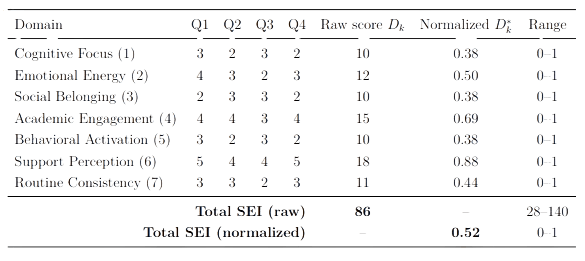Introducing the Student Experience Index (SEI)
Author: Dhruv Gupta
Email: d@annorth.xyz
Published: 2:45am, 24th October 2025, IST
Affiliation: Founder, Annorth AI
Abstract
Abstract
The Student Experience Index (SEI) is a brief self-report instrument I developed to measure a broad set of student-centred domains relevant to learning and wellbeing. Unlike screening tools that target a single construct (e.g., PHQ-9 for depressive symptoms), the SEI covers seven theoretically grounded domains: Cognitive Focus, Emotional Energy, Social Belonging, Academic Engagement, Behavioral Activation, Support Perception, and Routine Consistency. The instrument comprises 28 items (4 per domain) rated on a 5-point Likert scale (1–5). This manuscript describes the rationale, instrument design, scoring method, normalization, and a worked example.
1. Introduction
1. Introduction
Students' experience at school or college influences learning outcomes, mental health, and long-term trajectories. Existing standardized brief screening tools (e.g., PHQ-9; GAD-7) are clinically useful but focus primarily on mood or anxiety. Educational outcomes and day-to-day student functioning are influenced by multiple non-clinical domains such as attention, energy, sense of belonging, engagement, initiative, perceived support, and daily routines. I developed the Student Experience Index (SEI) to capture a broader, policy-relevant snapshot of student experience that schools and colleges can act upon.
1.1 Problem Statement
Single-construct brief instruments are limited for operational school use: they may flag clinical risk but do not capture domains schools can systematically change (e.g., teacher support, class engagement strategies). There is a need for a short, actionable instrument that is (a) easy to administer, (b) interpretable by non-clinical stakeholders, and (c) covers multiple domains that relate to academic and wellbeing outcomes.
1.2 Objectives
- Design a 28-item instrument spanning seven theoretically-plausible domains that are relevant to student experience.
- Provide a simple scoring method that is transparent and accessible to school administrators.
2. Theoretical Framework
2. Theoretical Framework
The SEI's seven domains were chosen by synthesizing educational psychology, well-being frameworks, and practical perspectives on school-based interventions:
- Cognitive Focus: Attention and sustained concentration are core to learning; poor focus predicts lower academic gains.
- Emotional Energy: Motivation and energy influence participation and persistence on tasks.
- Social Belonging: Sense of belonging is linked to attendance, engagement, and reduced dropout risk.
- Academic Engagement: Interest and active participation drive learning outcomes and self-regulation.
- Behavioral Activation: Initiative-taking and task activation are practical indicators of functioning and agency.
- Support Perception: Perceived availability of support (teachers/mentors) moderates stress and promotes help-seeking.
- Routine Consistency: Daily routines (sleep, meals, study patterns) are behavioral correlates of cognitive, emotional, and academic functioning.
3. Methodology: Instrument Design
3. Methodology: Instrument Design
3.1 Items and Response Format
The SEI contains 28 items, 4 items per domain. Each item uses a 5-point Likert scale:
Responses are coded numerically from 1 (least) to 5 (most).
3.2 Raw Scoring
For domain k (where k = 1..7), there are four item scores Qk,1, ..., Qk,4. The domain raw score Dk is the unweighted sum:

The total SEI raw score is the sum of domain scores:

3.3 Normalization
To allow domain comparisons and to keep the scale compatible with weighted aggregation, each domain score is normalized to the interval [0, 1] using linear min–max scaling:

The normalized SEI score is then computed as the average of the seven normalized domain scores:

4. Worked Example (Raw and Normalized Scoring)
4. Worked Example (Raw and Normalized Scoring)
Below is an example respondent's answers, raw scoring, and normalized values.

Table 1: Example respondent: item-level answers, domain raw scores, and normalized scores
5. Discussion
5. Discussion
The SEI is designed to be short, actionable, and interpretable by educational stakeholders. The raw scoring approach (sum of 28 items) keeps transparency. Domain scores (out of 20) give clear targets for school-level interventions (e.g., if Social Belonging is low, target peer and group strategies). The normalization step further allows meaningful cross-domain and cross-student comparisons.
Advantages:
- Multi-domain coverage (actionable to schools)
- Simple scoring and reporting (raw totals and normalized scores)
6. Conclusion and Future Directions
6. Conclusion and Future Directions
The SEI is a practical tool to provide an integrated snapshot of student experience across seven actionable domains. Next steps are: larger multisite validation, translation and cross-cultural adaptation, integration into a digital dashboard for schools, and exploration of predictive validity with academic outcomes and attendance.
Appendix A: Full Item List
Appendix A: Full Item List
Domain 1: Cognitive Focus
- How easy was it to concentrate during class this week?
- How rarely did your thoughts wander during academic tasks?
- How well could you stay focused on assignments without distraction?
- How often did you understand things without needing to re-read or rewatch them?
Domain 2: Emotional Energy
- How often did you feel energized to start your school day?
- How often did you have enough energy to complete tasks?
- How motivated did you feel about upcoming assignments or events?
- How often were you able to continue tasks without needing breaks due to low energy?
Domain 3: Social Belonging
- How often did you feel included in group conversations or activities?
- How connected did you feel to your peers this week?
- How often did you feel like you had someone to talk to at school?
- How often were you comfortable in expressing your opinions around classmates?
Domain 4: Academic Engagement
- How interested were you in the subjects taught this week?
- How often did you participate or raise questions in class?
- How often did you feel engaged while working on schoolwork?
- How often did you put effort into assignments or projects?
Domain 5: Behavioral Activation
- How often did you volunteer or take initiative in group settings?
- How often did you actively join school-related activities this week?
- How easy was it to start a new task or complete small goals?
- How consistent were you in completing planned activities?
Domain 6: Support Perception
- How often did you feel supported by teachers this week?
- How comfortable did you feel seeking help from adults at school?
- How often did someone acknowledge your efforts or progress?
- How easy was it to find encouragement when facing a challenge?
Domain 7: Routine Consistency
- How often was your sleep schedule regular over the past week?
- How often did you eat meals at consistent times?
- How well did you follow a daily routine for study or rest?
- How often did you complete your planned daily tasks?
